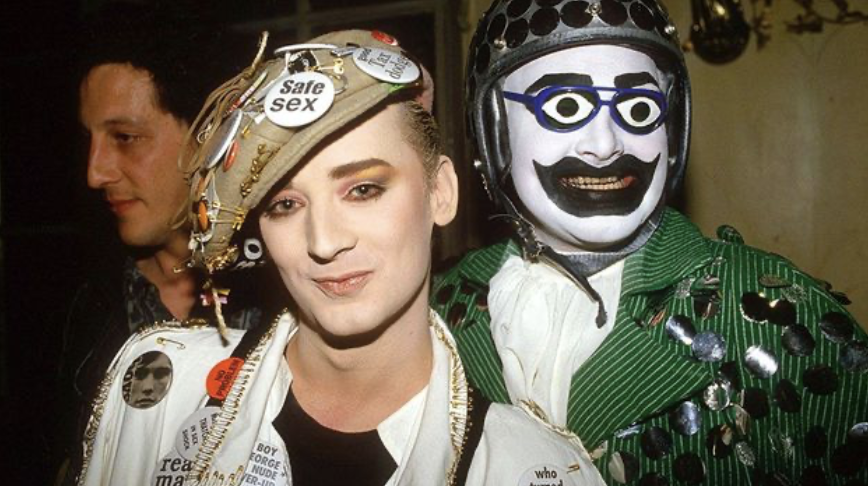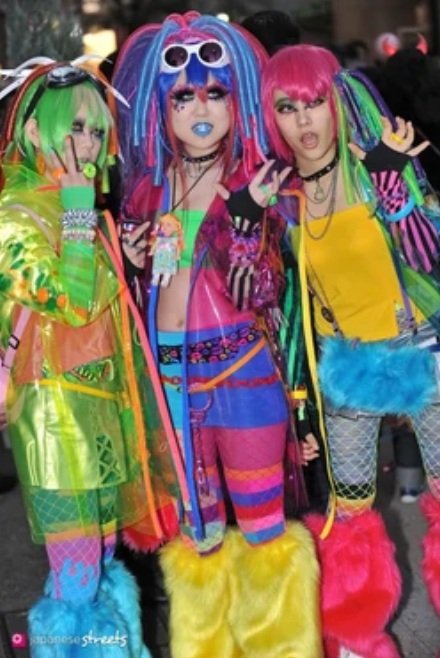Furvolution: Rave Wear and High Fashion
Nightlife has always had an influence in the high fashion scene, looking at John Galiano and Alexander McQueen’s inspirations in the 1980s and 1990s. According to fashion journalist Dana Thomas in the Evening Standard, they took direct influences from their club adventures, and McQueen specifically in the house and the underground rave scene. This is no different 40 years later. Club and rave culture continue to influence designers and fashion houses with new age rave culture that has been heavily influenced by digital spaces.
John Galliano on a night out.
(BBC)
Raves began to emerge in the 1980s and were (and still are) characterized by dance and electronic music, party drugs, and unconventional clothing choices. Initially, a style of clothing was not associated with ravers, however by the 90s a certain attire became rave wear. Bright colors and an overall “psychedelic” feel took over the 90s rave scene, especially with the introduction of boiler suits.
90s Ravers in Boiler Suits (The Guardian)
With the new millennium, rave attire shifted to follow abstracted 2000s fashion trends using cyber and furry details. Furry leg warmers and neon colors followed the 20-year trend cycle with 80s mainstream influence bleeding into the underground rave scene. As we dive into the 2020s, 2000s rave wear becomes especially influential under the 20-year trend rule as those elements return in their own evolved form in the present day rave culture.
Cyber Goth Ravers from 00s (by user by Kaori1531 from Aesthetics Wiki)
As the 2010s approached, rave wear began to have tighter silhouettes, reminiscent of more “casual” rave attire from the 90s. This shift is likely to also be influenced by the popularity of outdoor festivals like Coachella and the emphasis of EDM rather than house music. High fashion spaces also followed this shift in rave wear influences. Psychedelic looks and acid colors heavily influenced collections from the 2010s, most notably the Prada Fall 2018 collection, Miu Miu Resort 2017, and other references to 90s rave culture in Raf Simons FW18.
Prada FW18
Now that the 2010s are behind us, rave styles (and in turn high fashion inspirations) turn back to the 2000s with a digital and fur renaissance. Outdoor festivals have been on the decline after the COVID-19 pandemic, and what has emerged on the other side is a flourishing underground rave scene. Major hotspots for this scene are in Los Angeles, Bushwick, and expanding to all major cities. In LA specifically, the underground rave scene ranges from warehouse to lot raves in varying degrees of notoriety from unknown 20-something year old hosts to Subculture who are collaborating with Boiler Room. What gave rise to the budding underground rave scene post-pandemic is multifactored, but the main influences are the embrace of the internet, development of music, and 20-year trend cycle.
In the turn of the century, the rise of the digital age brought new fears and new influences to general pop culture and society, largely known today as Y2K. The internet has now come to be embraced in all its glory and anxieties. Currently, we live in the age of social media, willingly or not, and entering an era where now young adults have grown up with the internet. For better or worse, it has shaped how we navigate and heavily influenced our perceptions of the world. As the 2000s was a time of foreignness with the internet, the 2020s is a time of full familiarity with it. This has created the grounds for similar approaches to contemporary counterculture with distinct differences; one focused on novelty and the other focused on nostalgia. The approach to raves and rave attire is not exempt from this.
Music is also a major factor in the revival of 2000s rave styles. The 2010s saw a turn away from house music towards EDM, but coupled with the development of new age breakcore and the mainstream house comeback, underground raves moved away from headbanging to a dancing delirium. Breakcore gets labeled as an internet genre of music characterized by fast bpm and a crowded noise, however breakcore has been a microgenre of music since the 90s and was a shoot-off of jungle, drum and bass, and hardcore. In new age breakcore, artists like TOKYOPILL, Sewerslvt, etc., have created a new audience for club music culture. Dance music and DJ sets are definitely in their comeback which are molding rave wear with this “internet genre” label.
Silhouettes of 2000s rave attire has seen a resurgence in current rave trends, especially with the sensibilities of cyber goth. However, the 2020s spin focuses more on nu-metal and emo influences rather than goth and takes elements from niche internet coves for aesthetics, for example the collection of keychains of game characters from our childhoods and anime. 2020s ravers take on an abstracted form of 2000s ravers as they mix current fashion trends and sensibilities with elements from that time. For example, with the spread of “coquette” aesthetics, some ravers blended those elements to create a merged look taking ribbons and bows and darker colors with 2000s silhouettes with fur boots and layered, short skirts.
Still, certain sensibilities of the 2000s raver have come to stay with new era underground ravers– the use of fur. Upon entering a dinky warehouse, commonalities of dress are easily spotted through the colored lights flashing to the rhythm of bouncy, chopped up nightcore mix vocals. Fur boots, fur leg warmers, fur wrist cuffs, fur hoods, fur paws, and even the occasional fursuit fill up the cramped spaces of the room. Aside from the natural flow of the 20-year trend cycle, the prevalence of fur in today’s underground rave scene can be attributed to significant moments of internet culture in recent years based on my own firsthand experience.
(TikTok User @723mars)
Aspects of the furry lifestyle have come to be slightly more acceptable through the use of online communities and the growth of them through apps like TikTok and more mainstream furry-esque media being popular. Markiplier, a YouTube personality, has a long history with the horror video game, Five Nights at Freddy’s, or FNAF, and the popularization of it. FNAF is a game that features animatronics and fans and cosplayers of the game have been categorized with the furry fandom. In December 2021, Markiplier released the first part of his playthrough of FNAF: Security Breach which has now amassed 31,660,148 views and 1.1 million likes on YouTube. With this much internet presence, FNAF was inescapable even in the mainstream during that era where most people have at least heard or seen Freddy Fazbear. In addition to the ease of navigating niche internet communities with TikTok and the reach of them, furry adjacent groups became slightly more known and normalized, although still very much outcasted.
Furthermore, in 2020, there was the unfortunate trend of catboy maids. Popular male Tiktok stars all seemed to hop on the bandwagon of putting on cat ears and a maid costume for female attention which in turn normalized aspects of furries in mainstream society. I would also add popular movies like Zootopia and such brought more endearment to animorphic creatures. The normalization of pulls from the furry fandom paved the way for the trends we see on runways now.
Now, how does this all connect to high fashion? There has always been a pattern of fashion designers being inspired by nightlife and the aesthetics of the underground rave scene, so it is only the natural flow of the circle of fashion inspirations to take from the budding styles of current party goers. The fur extravaganza of the sweat flooded alleys, lots, and warehouses has bled into the world of runways, editorials, and industry.
From left to right: Lisa Von Tang FW22, AVAVAV SS23, Xue Huizi in Alaia by James Brodribb and Shibon Kennedy, Germanier SS23
Fall Winter 22 collections saw its fair share of fur embellishments throughout different runways. Fur coats seemed like a necessity for the season as they were highlighted in Versace, Armani, Yuhan Wang, Blumarine, Michael Kors, among others, FW22 collections. Although these may seem like a given considering the season, other fuzzy adornments were also eye-catching across runways of the season. Most notably are from Lisa Von Tang and Christian Cowan where there are direct ties to a raver silhouette with fuzzy leg warmers and boot details. Fur and fuzzy sensibilities continued into Summer Spring 23 collections and clothing pieces as well which solidified this raver revolution.
The most direct references of the furry raver tastes were in the exciting runway show of AVAVAV in their SS23 Milan Fashion Week runway show. AVAVAV made fashion breaking news with Beate Karlsson’s debut as each model down the runway posed a shocking fall, bringing back simple and fun runway antics. This collection featured hoodies, caps, bodysuits, cutouts, denim, and unmissable fur boots. It is undeniable that this collection took nods to streetwear and rave attire with the mixing of common streetwear items, like hoodies, with cutouts, the pairing of big fur boots, and bodysuits.
AVAVAV was not alone on fur embellished legs. In T Magazine, the NYTimes style magazine, Xue Huizi is photographed in giant fur boots from Alaia by James Bodribb and Shibon Kennedy for an August 2022 shoot. This goes to show a larger movement of fur boots and leg warmers taken from rave influences. These are not isolated incidents, but a larger cultural movement towards rave attire with high fashion sensibilities.
The fur trend as it cycles through fashion houses is also becoming more abstracted. Germanier SS23 takes fur full on with bright colors and fun utilizations. This collection also takes the silhouettes of rave attire that would typically use fur with other materials. One detail from the collection is the pom pom and beaded leg warmers. Abstractions of current trends are always exciting to see emerge as these designers introduce new forms of existing palettes that will then influence future attire.
I would also argue that the Diesel SS23 collection also included abstractions of the larger rave fur influence. Throughout the collection, heavily distressed denim makes appearances in a fuzzy manner. In one of the looks, the fuzzy denim forms a look like a tube top and tutu which are staples of nightlife clothing.
Diesel SS23 MFW
A possible factor for the abstraction of fur with regards to experimentation with materials is due to a continuous hesitation of fur with the ongoing climate crisis. It is interesting to see where the next seasons of fashion will take us as fur aesthetics are here to stay, but moving away from fur being used. Innovation in fashion is forthcoming while following regimented patterns of inspirations.
As we dive deeper into a digital world, the developments it brings with aspects of past trends are shaping current fashion trends and inspiring their own modern day abstractions. Fur is here to stay for now, but as always, trends come and go. Time moves on, and with it current trends as well. Where will they take us next? I am not sure yet, but a night out is sure to show us the light.












